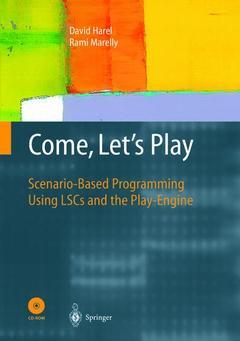Come, Let's Play, 2003 Scenario-Based Programming Using LSCs and the Play-Engine
Auteurs : Harel David, Marelly Rami

David Harel is the Dean of the Faculty of Mathematics and Computer Science at the Weizmann Institute of Science in Israel. He is also co-founder of I-Logix, Inc., Andover, MA, and of SenseIT Technologies, Ltd. (DigiScents Israel). His research interests are in theoretical computer science (especially computability, automata theory and logics of programs), and in software and systems engineering (especially specification and modeling, object-oriented analysis and design, and visual languages), as well as the aesthetic layout of diagrams, clustering algorithms and the synthesis and communication of smell. He is the inventor of the language of statecharts (1983), was part of the team that designed the Statemate (1984-1987) and Rhapsody (1997) tools, and was co-inventor of LSCs (1998). His work is central to the behavioral aspects of the UML. He devotes part of his time to expository work: In 1984 he delivered a lecture series on Israeli radio, and in 1998 he hosted a series on Israeli television; some of his writing is intended for a general audience (see, for example, Computers Ltd.: What They Really Can't Do , Oxford University Press, September 2000). He has received a number of awards, including ACM's Karlstrom Outstanding Educator Award in 1992, and the 1997 Israeli Prime Minister's Award for Software. His book, Algorithmics: The Spirit of Computing (Addison-Wesley, 1987, 2nd. edn. 1992) was the Spring 1988 Main Selection of the Macmillan Library of Science. He is a Fellow of the ACM and of the IEEE.
THE book presenting the elegant and powerful new method and tool for software and systems engineering called Play-Engine
Includes supplementary material: sn.pub/extras
Date de parution : 06-2003
Ouvrage de 382 p.
17.8x25.4 cm



